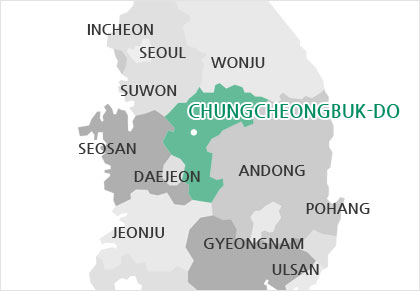Chungbuk has Sobaeksan and Charyeongsan Mountains
Chungbuk consists in one geographic region and the west longitude consists of hilly areas and plains, forming a relatively open, high-in-the south, low-in-the-north terrain. The Sobaeksan Mountain bordering Gyeongbuk and Jeonbuk is a mature mountain which is relatively rugged.
Chuncheongbuk-do, being located in the center of the Korean Peninsula is an inland region. It is the only inland province in Korea. Even Seowunsan mountain, at the western end of Baekgok-myeon, Jincheon-gun, the closest location to the sea, is located 47km from the breakwaters of Asan Bay in Chungcheongnam-do
As such Chuncheongbuk-do forms a giant basin locked in by the Taebaek Mountains on the northeast side, the Sobaek Mountains on the east side and the Charyeong Mountains on the northwest side, so it has a unique continental climate which is quite rare in Korea. For example, Chungju on the north side has temperatures 2℃ lower than that in Seoul on average in January, with Jecheon at 3℃ lower and
Chupungnyeong on the south side is 2℃ lower than in Pohang which is located at the same latitude. In addition, the eastern border runs along the rugged Taebaek and Sobaek Mountains and has an upland agricultural landscape, which is similar to Gangwon-do. Consequently, the trait of residents tends to be tender and warm and demonstrate a strong loyal spirit.
However, due to the recent expansion of transportation means such as railroads and expressways and of communication facilities, as well as the construction of large plants across the province, the trait of Chungbuk is changing to be adventurous. Before the areas of the Amnokgang and Dumangang river were resized during the Joseon Dynasty, Anju and Yeongheung used to be the border of Korea and the center of Korea used to be Chungju. That is, the distance from Chungju to Anju is 360km, to Yeongheung is 300km to Busanpo is 250km and to Mokpo is 280km. Thus, the name ‘Jungwon’ or ‘Chungju’ was proudly used, and the Jungangtap Pagoda (meaning Central Tower) which symbolized the center of the Korean Peninsula and was designated as National Treasure No. 6, is located in Jungangtap-myeon (Gageum-myeon).
Chungcheongbuk-do forms a close relationship with its surrounding areas while still keeping its unique characteristics. As the province is bordered with Gyeonggi-do and Gangwon-do on the north, Gyeongsangbuk-do on the east, Chungcheongnam-do on the west and Jeollabuk-do on the south, it forms an independent geographical region. However, as the Geumgang River is located on the border with Chungcheongbuk-do, it has been irrigating the immense plains and playing an important role in promoting exchanges between the two provinces since the olden days, so the two provinces have been forming similar regional cooperation.
If we assume the two provinces as the same region, Cheongju, Gongju and Daejeon are located in the center and can be considered as the center of politics, economy and culture, sharing the same cultural zone. There is the Charyeong Mountains on the border area with Gyeonggi-do on the north, and since the area with low altitude, it does not hamper transportation. Consequently, the area has been growing as part of the central cultural zone since the olden days. The Sobaek Mountains on the east used to be a boundary between Baekje Dynasty and Silla Dynasty in the olden days and has been serving as a boundary between Jungbu, Yeongnam, and Honam cultural zones.
However, with the opening of the Gyeongbu and Jungang Railroad during the early 1900s and the subsequent construction of the Honam Railroad, the geographical boundary began to be dismantled. With the opening of the historic Gyeongbu Expressway in July 1970, the construction of the Jungbu Expressway, the Jungbu Naeryuk Expressway, the Jungang Expressway, the Honam Expressway, and the Yeongdong Expressway was completed, and as a result, the barrier of Sobaeksan Mountain was completely removed, allowing Yeongnam and Honam areas accessible within a day.
Furthermore, as Chungcheongbuk-do is located in the center of the Korean Peninsula, it is an optimal place that can achieve balanced national development and national unification. Centering around Cheongju International Airport, which was opened on April 28, 1997, and the KTX Osong Station which is the only branch station of the express train, Chungcheongbuk-do is expected to play a core role
